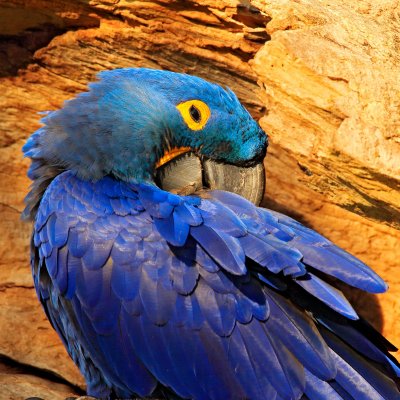The paradise of parrots in Barranco Alto
I keep walking around a massive old tree and I can´t believe, that there is a hollow with nesting macaws only 200 meters from the place, which became our home for the following two weeks. When I was arranging our short stay in Brazilian Pantanal, I felt, that Barranco Alto and its surroundings could be the right place to watch hyacinth macaws in the wild. However, my expectations were surpassed by reality. A nest within view!
As it turned out 200 kilometres to the northwest from Campo Grande after two weeks, there were up to five pairs of these blue dishy guys living in the surroundings. In fact, there wasn´t any day when I didn´t meet any hyacinth macaw on my rambles in the Brazilian countryside. After a few days I even made a sophisticated way of walking around those places, where the birds were staying during the day. They went to drink at some of the places, to frolic early in the morning; they ate nuts in the palm trees. I recorded four nests and I knew the place, where the birds gathered into a bigger group every evening.
Despite the fact, that Brazilian Pantanal is a perfect place for capturing and watching animals, where it is really difficult to decide immediately, what to focus on at one moment, I always preferred to watch a hyacinth macaw, if there was one in sight. Hyacinth macaws prefer open flat landscape with lonely trees to deep primeval forests. Not because they wouldn´t like the original primeval forests, but because they had to adapt themselves as there weren´t many of the primeval forests left. Pantanal with its meadows, flooded areas, pastures and islands of woods is an ideal place for the hyacinth macaws to live. You can find them near palm groves, in savannahs and dry sparse woods.
Unfortunately, although hyacinth macaws were originally widespread on a large territory of South America, nowadays they can be found only within three little areas. Two of them are in the southern part of the Brazilian Amazon basin and the last one is in the southern part of Brazil near the east border towards Bolivia and the northeast border of Paraguay. This is where hyacinth macaws were explored by me.
Hyacinth Macaw (Anodorhynchus hyacinthinus), Barranco Alto, Pantanal, Brazil
Ondřej Prosický | www.NaturePhoto.cz, Canon EOS 5D Mark II, EF500mm f/4L II USM, f/9.0, @1/40 s, ISO 500, 6. září 2011 14:19:50



 Brazílie
Brazílie
Comments
(0 posts) Add comment